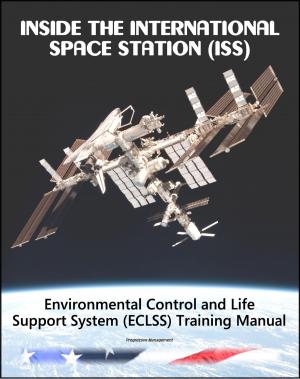Inside the International Space Station (ISS): NASA Operations and Planning Astronaut Training Manual
Nonfiction, Science & Nature, Science, Physics, Astronomy| Author: | Progressive Management | ISBN: | 9781465797520 |
| Publisher: | Progressive Management | Publication: | December 19, 2011 |
| Imprint: | Smashwords Edition | Language: | English |
| Author: | Progressive Management |
| ISBN: | 9781465797520 |
| Publisher: | Progressive Management |
| Publication: | December 19, 2011 |
| Imprint: | Smashwords Edition |
| Language: | English |
Learn about the International Space Station (ISS) from the textbooks used by the astronauts! These astronaut and flight controller training manuals, produced by the Mission Operations Directorate (Space Flight Training Division branch) at NASA's Johnson Space Center, represent a major part of the formal flight crew training process. The manuals and workbooks are extremely detailed and comprehensive, and are designed for self-study. A full listing of all acronyms and abbreviations used in the text is included. They provide a superb way to learn about Station systems, hardware, and operational procedures. Special emphasis on crew interaction with the displays, controls, and hardware is included.
This training manual covers the ISS operations and planning process. Unlike previous projects in U.S. human space flight, the International Space Station (ISS) will operate on a continuous basis, with execution planning, logistics planning, and on-orbit operations occurring simultaneously for long periods of time. Additionally, the sheer size and unique constraints of Station compared to Shuttle demand a somewhat different approach to both planning and operations.
The ISS planning process is very complex and involves many interfaces and products. Utilizing the results of this planning process for operations as well as translating the results of current operations into future planning is a sophisticated process. This section introduces the overall process, arid several products and activities of each of the four phases of ISS planning that are important aspects of real-time Station operations. How these activities are performed on-orbit will also be described.
Many factors make planning for ISS more complex than previous programs. The first is product delivery dates. Some products, such as flight software, are required for every ISS assembly flight at launch minus (L-) X months. Others, such as the Multilateral Increment Training Plan, are produced for an entire increment (which may include several launches) at Increment minus (I-) X months. Since an increment can include several flights, the challenge is to synchronize templates and product delivery dates. The second challenge is international integration which includes issues such as the language of operations and documentation and merging different cultural styles of planning, as well as conforming to memorandums of understanding between international organizations. Just integrating programs is a significant challenge - not only merging International Partner (IP) programs with NASA programs, but also merging the NASA programs (Space Shuttle and Space Station) themselves. The Shuttle program is very stable and is trying to shorten its planning templates, but the Space Station program is very new and is establishing more conservative templates. Shared products under these different styles and priorities for planning are sometimes difficult to schedule together. The final area that is a particular challenge to ISS is resource management. Crew time, power, communication time, and bandwidth are just some of the resources that are limited for ISS, and must be managed to achieve ISS objectives. Many of these resources, such as crew time, also fall under partner allocation agreements made at the program and government level. Planners from all the Partners will work together to ensure that each Partner is receiving an appropriate amount of resources over time.
Learn about the International Space Station (ISS) from the textbooks used by the astronauts! These astronaut and flight controller training manuals, produced by the Mission Operations Directorate (Space Flight Training Division branch) at NASA's Johnson Space Center, represent a major part of the formal flight crew training process. The manuals and workbooks are extremely detailed and comprehensive, and are designed for self-study. A full listing of all acronyms and abbreviations used in the text is included. They provide a superb way to learn about Station systems, hardware, and operational procedures. Special emphasis on crew interaction with the displays, controls, and hardware is included.
This training manual covers the ISS operations and planning process. Unlike previous projects in U.S. human space flight, the International Space Station (ISS) will operate on a continuous basis, with execution planning, logistics planning, and on-orbit operations occurring simultaneously for long periods of time. Additionally, the sheer size and unique constraints of Station compared to Shuttle demand a somewhat different approach to both planning and operations.
The ISS planning process is very complex and involves many interfaces and products. Utilizing the results of this planning process for operations as well as translating the results of current operations into future planning is a sophisticated process. This section introduces the overall process, arid several products and activities of each of the four phases of ISS planning that are important aspects of real-time Station operations. How these activities are performed on-orbit will also be described.
Many factors make planning for ISS more complex than previous programs. The first is product delivery dates. Some products, such as flight software, are required for every ISS assembly flight at launch minus (L-) X months. Others, such as the Multilateral Increment Training Plan, are produced for an entire increment (which may include several launches) at Increment minus (I-) X months. Since an increment can include several flights, the challenge is to synchronize templates and product delivery dates. The second challenge is international integration which includes issues such as the language of operations and documentation and merging different cultural styles of planning, as well as conforming to memorandums of understanding between international organizations. Just integrating programs is a significant challenge - not only merging International Partner (IP) programs with NASA programs, but also merging the NASA programs (Space Shuttle and Space Station) themselves. The Shuttle program is very stable and is trying to shorten its planning templates, but the Space Station program is very new and is establishing more conservative templates. Shared products under these different styles and priorities for planning are sometimes difficult to schedule together. The final area that is a particular challenge to ISS is resource management. Crew time, power, communication time, and bandwidth are just some of the resources that are limited for ISS, and must be managed to achieve ISS objectives. Many of these resources, such as crew time, also fall under partner allocation agreements made at the program and government level. Planners from all the Partners will work together to ensure that each Partner is receiving an appropriate amount of resources over time.















